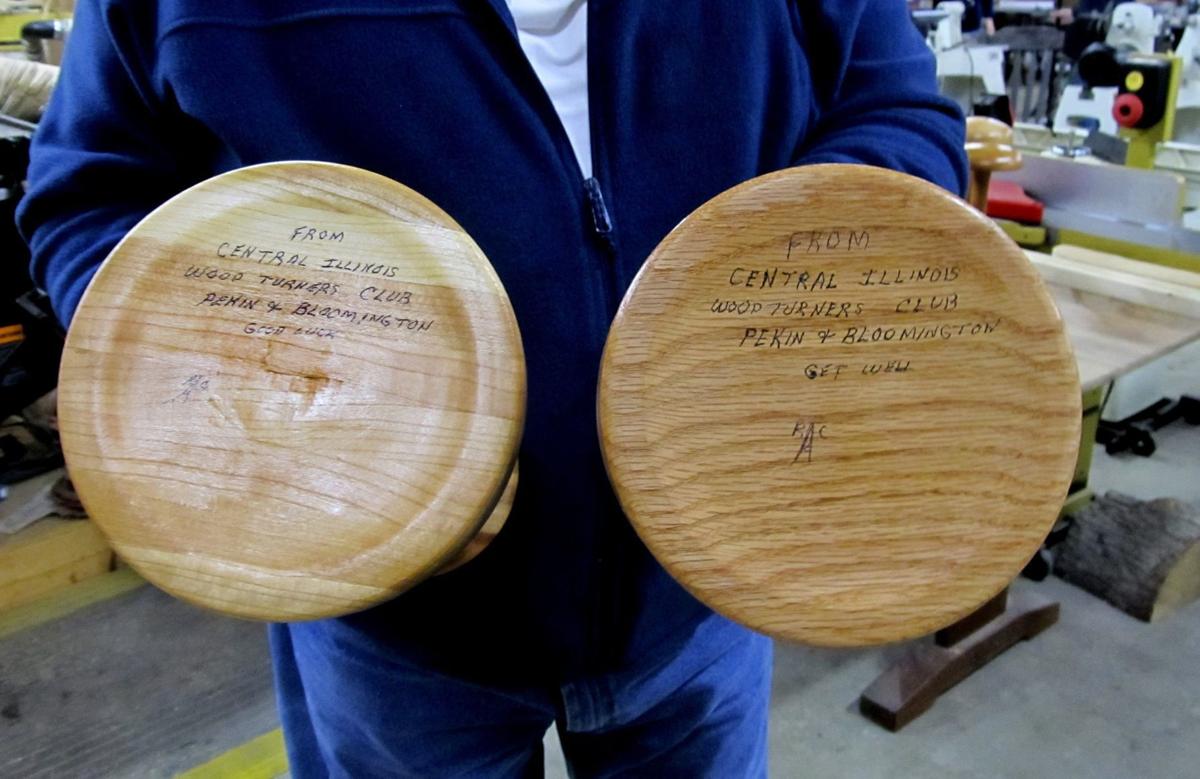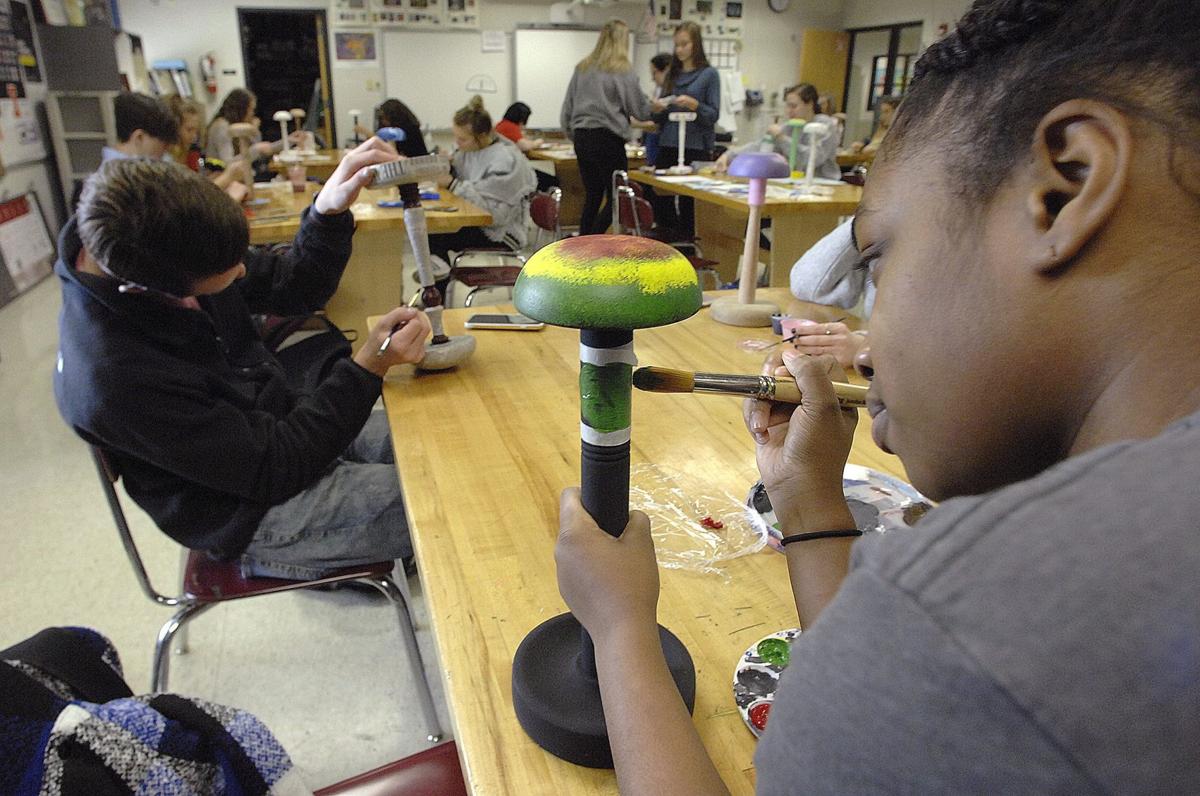
Members of the Central Illinois Woodturners, who are creating and donating the wig stands for female cancer survivors, write messages on the underside of each wig stand. These wig stands by Roger C. Alexander of Pekin wish recipients “Good Luck” and “Get Well.” PAUL SWIECH, THE PANTAGRAPH
Woodturners, NCHS students craft wig stands for cancer patients
“I’m not a believer that art you create is just for yourself,” said Jennifer Kelly, art teacher at Normal Community High School.
“Art is to be viewed by others,” Kelly said. “I want my students to know that their art can have an impact.”
As Kelly spoke during her Advanced Art Studio class on Feb. 13, students were busy painting and collaging wig stands. They will be donated to Central Illinois female cancer survivors who lose their hair as a side effect of chemotherapy to treat their cancer.
Among students was Kaylee Probst, an 18-year-old senior from Normal, painting her thumb different colors and then applying her thumbprint to a wig stand base, spindle and top to symbolize the uniqueness of each person’s cancer journey.
There was Sam Kortkamp, an 18-year-old senior from Bloomington, using Mod Podge to apply Wall Street Journal newspaper shreds to a wig stand to give it a “classy” look and to honor the intelligence of its future user.
And there was Sarah Leddick, an 18-year-old senior from Bloomington, painting flowers to symbolize beauty and the word “Strength” in pink as a nod to the strength of breast cancer survivors.
“I’m really proud of my kids,” Kelly said. “They are putting their hearts into this.”
The NCHS art students painting and collaging the 37 wig stands this month is the latest chapter in a story that began last spring when members of the Central Illinois Woodturners began creating and donating wig stands to female cancer survivors.
The woodturners donated 250 wig stands last year to the Susan G. Komen Memorial Affiliate, which distributed them throughout its 36-county service area that includes McLean County, and to Southern Illinois University School of Medicine in Springfield.

DeHarra Jones, 18, a senior in Jennifer Kelly’s art class, paints her wooden wig stand during class on Feb. 13 at Normal Community High School. DAVID PROEBER, THE PANTAGRAPH
Thirty-seven wig stands were created last month and shared with the NCHS students in a new partnership.
“They’ll be a lot more coming,” woodturner Mark Toon of Bloomington, said during a recent woodturners meeting at the Woodworkers Shop in Pekin.
“We hope to exceed last year’s count,” said woodturner and club president Roger L. Alexander of Bloomington.
“It has been amazing to see the responses, not only of the health care professionals, but from the patients who’ve received them,” said Gayle Young, mission director for the Komen Memorial Affiliate. “People have been moved that someone would take an artistic talent and use it to help others.”
Cancer patients receiving chemotherapy frequently lose their hair. Many women get wigs.
But most women don’t have anything special on which to store their wig when they aren’t wearing it.
“Some women have told us, ‘I didn’t know what to do with my wig. I was using an old milk jug,'” Young said.
Lisa Lowry, breast health navigator at the Community Cancer Center in Normal, said some women use Styrofoam heads.
Woodturner Terry Quiram became aware of this service gap and brought it to the attention of fellow members of the Central Illinois Woodturners.
Woodturning is a form of woodworking in which a lathe is used to make items that are generally round, such as bowls and vases. The group has about 60 members who meet monthly, alternating meetings between Bloomington and Pekin.
Creating and donating items wasn’t new to the group. But making wig stands for female cancer survivors resonated with the woodturners.
“We all have mothers and wives and daughters and sisters,” Alexander said. “It affects all of us.
“This is a chance for the club to give back to the community that supports us,” Alexander said.
A company in Chillicothe donates scrap wood. “It’s hard wood — maple, walnut, cherry and oak,” said woodturner Hod Bailey of Metamora.
Quiram cuts the wood and turns it into round pieces for the top and bottom and a square piece for the spindle. Then he turns each kit over to a club member.
Each club member puts each piece of wood on their lathe and turns it. Each piece is sanded, then covered with polyurethane.
Each woodturner creates each piece differently, so each piece is unique. In addition, club members put a message on the underside of each base.
For example, woodturner Roger C. Alexander of Pekin wrote “From Central Illinois Woodturners Club, Pekin & Bloomington, Good Luck” or “”Get Well” and then added his initials to the bottom of several wig stands he brought to the Feb. 12 meeting.
“It give us a chance to help somebody,” Roger C. Alexander said. “I’m a patient at SIU for cancer of the neck. It gives me a chance to help another cancer patient. I have a feeling for what they feel.”
Each wig stand takes three to five hours to create, Roger L. Alexander said.
While Roger C. Alexander has taken some of the stands to SIU in Springfield, most of them go to Komen in Peoria, which has distributed them to doctors’ offices and cancer centers throughout Central Illinois, Young said.
“For some women, losing their hair is a traumatic part of their breast cancer journey,” Young said. “This helps them to know that someone else is thinking about them.”
Some of the wig stands went to the cancer center in Normal, which has shared them with an oncology practice and with Bloomington salons that have wig banks.
“Any chemo puts you at risk for losing your hair,” Lowry said. “We are making them available to any female cancer survivor who loses her hair, not just breast cancer survivors.”
“It’s a nice way for women to store their wig,” Lowry said. “The patients have loved them. It’s artwork.”
But the woodturners heard that some cancer survivors preferred colorful stands. So Toon asked Kelly in January whether her art students would be interested in painting some stands. She said “yes”.
Students began working on the stands a couple of weeks ago and are finishing this week.
Kaylee Probst, in addition to painting thumbprints, is adding a quote from Theodore Roosevelt: “Do what you can, with what you have, where you are.”
“I like it (the quote) because, in their (cancer) situation, having a hard time, they can still be doing something significant,” Probst said. “Their journey is so important.”
“I love this project,” Probst said. “I like the idea that we can share our art with someone else. We are impacting the community, not just ourselves.”
“This will raise the level of awareness of these students,” Young said.
Kelly said, “These kids will remember ‘Something of mine exists to help another person.'”
“When things happen that are out of your control, it’s nice to know that you’re not alone,” Kelly said.
View source and photos.
 Maine Wood Concepts, a maker of custom wood turnings, wooden tool handles and other custom molded wooden parts, is the manufacturer of the official 2018 White House Easter Eggs, which will be sold by The White House Historical Association (WHHA).
Maine Wood Concepts, a maker of custom wood turnings, wooden tool handles and other custom molded wooden parts, is the manufacturer of the official 2018 White House Easter Eggs, which will be sold by The White House Historical Association (WHHA).

 Will Arcularius and Brent Arnold are an unlikely set of woodcrafters. More than 50 years of age separate the two, one is retired and the other is home-schooled.
Will Arcularius and Brent Arnold are an unlikely set of woodcrafters. More than 50 years of age separate the two, one is retired and the other is home-schooled.




 (Saint Paul, February 21, 2018)—The
(Saint Paul, February 21, 2018)—The 